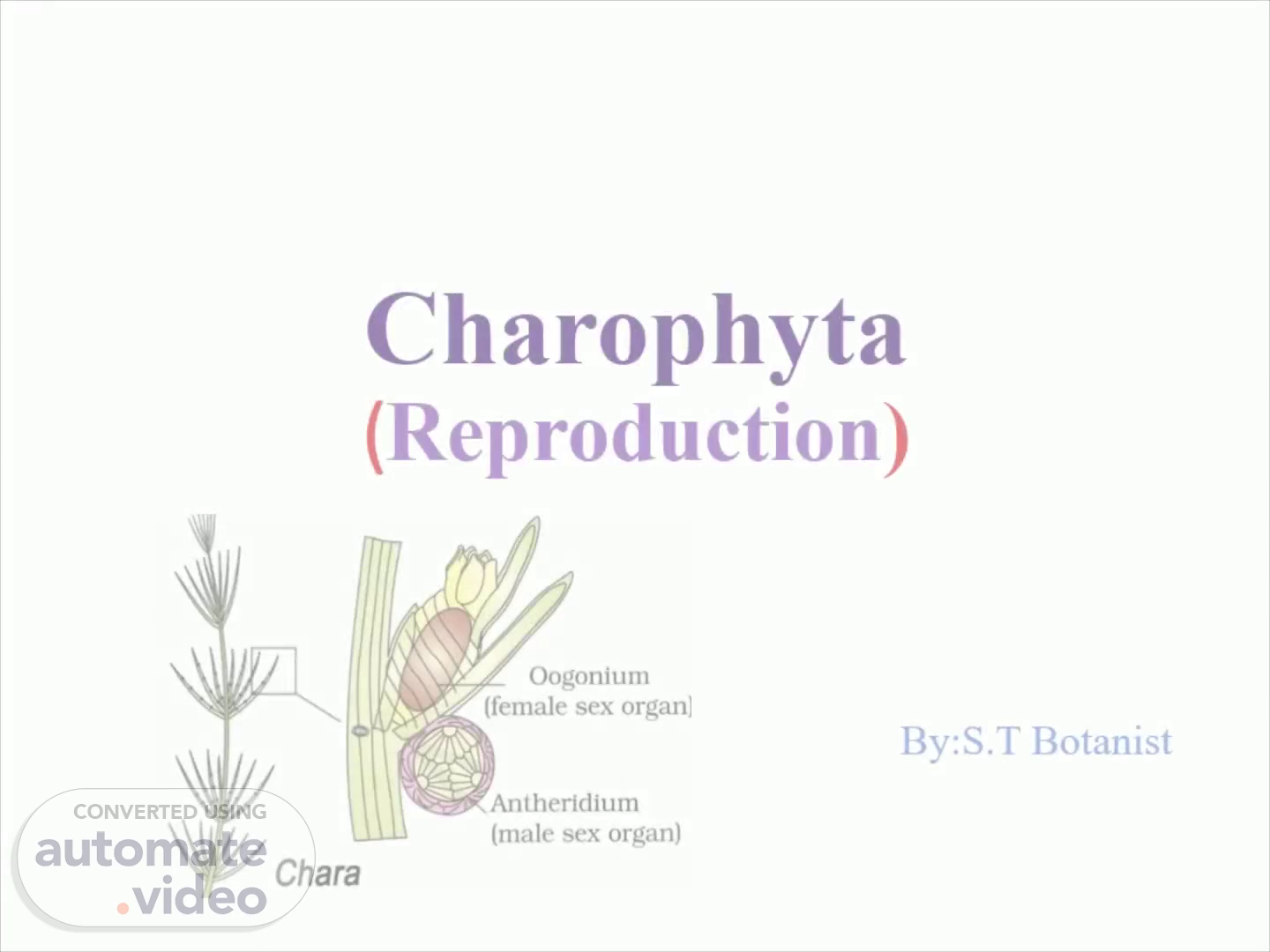
Charophyta (Reproduction)
Scene 1 (0s)
Charophyta ( Reproduction ). By:S.T Botanist.
Scene 2 (7s)
Reproduction. Two Types: 1- Vegetative reproduction 2- sexual reproduction (Asexual reproduction by spore formation is absent.) Vegetative Reproduction The common methods of Vegetative reproduction in chara are: Amylum stars Bulbils Amorphous bulbils Secondary protonema.
Scene 3 (20s)
Bulbil Small, oval Or spherical tube like structures develop on rhizoids or lower nodes of the main axis Under favourable conditions they detach from plant and develop into new thallus . Amorphous bulbils some species of Chara (e.g., C. fragifera ), many small cells aggregate at the lower node of the main axis or at rhizoids and form many lateral outgrowths called amorphous bulbils. They are laden with food materials..
Scene 4 (41s)
Amylum Stars They are star-shaped aggregates of cells They develop on the lower nodes of the main axis. These cells are densely filled with amylum starch and hence are called amylum stars. Secondary Protonema They are tubular or filamentous structures. They developed from the primary protonema ..
Scene 5 (57s)
Vegetative reproduction in chara A- stem bulbils B- root bulbils C- amorphous bulbils D- Amylum starsr.
Scene 6 (1m 6s)
Sexual Reproduction. Oogamous Sexual Reproduction in chara is of oogamous type Highest evolved form of reproduction. Nucule :female reproductive structure Globule : male reproductive structure Globule/Androecium It is spherical in shape Orange or yellow in colour . It is present below the nocule Basal stalk with the help of basal stalk it is attached with the main axis..
Scene 7 (1m 25s)
Sheiled cells Flate plate like structures Outermost layer of shield cells present which are 8 in number Shield cells contain xanthophyll and carotene because of which it appears yellow orange Maniburium . From the center of each shield cell arises tubular shaped structure called as maniburium . Head cells/ primary capitumum Maniburium at its ends have few rounded cells called as primary capitulum.
Scene 8 (1m 43s)
Secondary capitulum Primary capitulum cuts off a group of 6 cells on on outside called secondary capitulum Antheridial filament Thread llike structure present on secondary capitumum Each cell of antheridial filament acts as antherozoid mother cell which by the process of metamorphosis develop a biflagellatsd structure which is spiral shaped called as sperm ..
Scene 9 (1m 59s)
Globule. ANTHERIDIAL FILAMENTS MANUBRIUM SECONDARY CAPITULUM PEDICEL SHIELD CELL .0 0 PRIMARY CAPITULUM.
Scene 10 (2m 6s)
Oogonium / Nucule. Nucule is female sex organ. It is oval or elliptical structure It consists on two parts: Ovum/egg Tube cell Oogonium is (7mm) long s ructure which is attached to the node of the main axis with the help of stalk. The oogenium consists of one egg cell and 5 tube cells. The nucule is remained surrounded by 5 spirally twisted Tube cells these tube cells function as a protective sheath..
Scene 11 (2m 26s)
Nucule. Each tube cell terminates in a small erect cell at the Apex of the nucule called Corona cells. The Five corona cells form the crown. The nucule contain a single egg Cell which is filled with starch and oil..
Scene 12 (2m 41s)
Fertilization. During fertilization The spirally twisted Tube cells just below the corona separated slightly From one another and form five slits. The antherozoids are attracted towards mature egg Due to chemotactic response Antherozoid enter through these opening and penetrate Gelatinized Wall of the nucule Only one antherozoid Fertilizes the egg to form zygote . T he zygote secreted a thick wall to form oospore.
Scene 13 (2m 59s)
Germination. Under favourable conditions oospore germinate into new Chara plant Oospore nucleus divides by meiosis To form 4 ha ploid daughter nuclei The oospore is divided by a septum into two unequal haploid cells Lenticular cell: the Upper apical smaller Lenticular cell, contains a single nucleus Basal cell: it is large and contain 3 nuclei. The three nuclei of the basal cell degenerates gradually.
Scene 14 (3m 17s)
Germination of oospore. The Lenticular cell is exposed by by rupture of oospore wall It divides mitotically to form rhizoidal intial and protonemal initial The rhizoidal intial develop into rhizoids while protonemal initial develop into Erect green epiterranean primary protonema Then primary protonema is differentiated into nodes and Internodes the mature Chara plant arose as a lateral branch from protonema..
Scene 15 (3m 36s)
Life Cycle of Chara. .. amylum stars bulbils amorphous bulbils ndary protonema Asexual Reproduction CHARA (n) gl±ul n) nucule (n) protonema (n) Sexual Reproduction antherozoid (n) egg (n) meiosis rtilizati zygote.